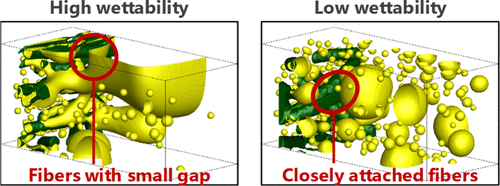当前位置:
X-MOL 学术
›
Ind. Eng. Chem. Res.
›
论文详情
Our official English website, www.x-mol.net, welcomes your feedback! (Note: you will need to create a separate account there.)
Effect of Surface Wettability on Droplet Coalescence and Pressure Drop in a Fibrous Filter: Direct Numerical Simulation Coordinated with X-ray Computed Tomography Images
Industrial & Engineering Chemistry Research ( IF 4.2 ) Pub Date : 2021-03-02 , DOI: 10.1021/acs.iecr.0c06157 Masaki Ueda 1 , Tomonori Fukasawa 1 , Toru Ishigami 1 , Kunihiro Fukui 1
Industrial & Engineering Chemistry Research ( IF 4.2 ) Pub Date : 2021-03-02 , DOI: 10.1021/acs.iecr.0c06157 Masaki Ueda 1 , Tomonori Fukasawa 1 , Toru Ishigami 1 , Kunihiro Fukui 1
Affiliation

|
In this study, the effect of surface wettability on the coalescence of oil droplets and pressure drop within a fibrous filter were investigated numerically. We simulated the permeation and coalescence of an oil-in-water (O/W) emulsion through a fibrous filter using our direct numerical simulation model based on the phase-field model, the immersed boundary method, and a wetting model that assigns an order parameter to the fiber surface. To appropriate the actual phenomena inside the filter, the microporous structure obtained from X-ray computed tomography (CT) images were employed in the simulation. With a low surface wettability, the arrangement of closely attached fibers at the permeating side of the filter domain promoted droplet coalescence. With a high surface wettability, the arrangement of small interfiber spacing placed at the permeate side significantly enhanced droplet coalescence, owing to the formation of a liquid-bridged structure between the fibers at the permeate side. The pressure drop increased with the high surface wettability. The liquid bridges that formed between the fibers at the permeate side blocked the flow path of the permeating fluid, causing a higher pressure drop. A sparse/dense structure, such as the closely attached fibers and small interfiber spacings at the permeate side, promoted droplet growth. Although the uniform fiber arrangement reduced the number of uncoalesced droplets passing through a filter, the coalescence performance is not very high, and the pressure drop significantly increases because the enlarged droplets block the flow path.
中文翻译:

表面润湿性对纤维过滤器中液滴聚结和压降的影响:与X射线计算机断层扫描图像配合的直接数值模拟
在这项研究中,数值研究了表面润湿性对纤维过滤器内油滴聚结和压降的影响。我们使用基于相场模型的直接数值模拟模型,沉浸边界方法和分配顺序的润湿模型,通过纤维过滤器对水包油型乳剂的渗透和聚结进行了模拟。纤维表面的参数。为了使过滤器内部的实际现象合适,在模拟中采用了从X射线计算机断层扫描(CT)图像获得的微孔结构。在低表面润湿性的情况下,紧密附着的纤维在过滤器区域的渗透侧的布置促进了液滴的聚结。表面润湿性高 由于在渗透物侧的纤维之间形成了液桥结构,因此在渗透物侧放置较小的纤维间距离的布置显着增强了液滴的聚结。压降随着高表面润湿性而增加。在渗透侧的纤维之间形成的液桥阻塞了渗透流体的流动路径,导致较高的压降。稀疏/密集的结构(如紧密连接的纤维和渗透侧的较小纤维间间距)促进了液滴的生长。尽管均匀的纤维排列减少了通过过滤器的未凝聚液滴的数量,但聚结性能不是很高,并且由于增大的液滴阻塞了流路,因此压降显着增加。由于在渗透侧的纤维之间形成了液桥结构。压降随着高表面润湿性而增加。在渗透侧的纤维之间形成的液桥阻塞了渗透流体的流动路径,导致较高的压降。稀疏/密集的结构(如紧密连接的纤维和渗透侧的较小纤维间间距)促进了液滴的生长。尽管均匀的纤维排列减少了通过过滤器的未凝聚液滴的数量,但聚结性能不是很高,并且由于增大的液滴阻塞了流路,因此压降显着增加。由于在渗透侧的纤维之间形成了液桥结构。压降随着高表面润湿性而增加。在渗透侧的纤维之间形成的液桥阻塞了渗透流体的流动路径,导致较高的压降。稀疏/密集的结构(如紧密连接的纤维和渗透侧的较小纤维间间距)促进了液滴的生长。尽管均匀的纤维排列减少了通过过滤器的未凝聚液滴的数量,但聚结性能不是很高,并且由于增大的液滴阻塞了流路,因此压降显着增加。在渗透侧的纤维之间形成的液桥阻塞了渗透流体的流动路径,导致较高的压降。稀疏/密集的结构(如紧密连接的纤维和渗透侧的较小纤维间间距)促进了液滴的生长。尽管均匀的纤维排列减少了通过过滤器的未凝聚液滴的数量,但聚结性能不是很高,并且由于增大的液滴阻塞了流路,因此压降显着增加。在渗透侧的纤维之间形成的液桥阻塞了渗透流体的流动路径,导致较高的压降。稀疏/密集的结构(如紧密连接的纤维和渗透侧的较小纤维间间距)促进了液滴的生长。尽管均匀的纤维排列减少了通过过滤器的未凝聚液滴的数量,但聚结性能不是很高,并且由于增大的液滴阻塞了流路,因此压降显着增加。
更新日期:2021-03-17
中文翻译:

表面润湿性对纤维过滤器中液滴聚结和压降的影响:与X射线计算机断层扫描图像配合的直接数值模拟
在这项研究中,数值研究了表面润湿性对纤维过滤器内油滴聚结和压降的影响。我们使用基于相场模型的直接数值模拟模型,沉浸边界方法和分配顺序的润湿模型,通过纤维过滤器对水包油型乳剂的渗透和聚结进行了模拟。纤维表面的参数。为了使过滤器内部的实际现象合适,在模拟中采用了从X射线计算机断层扫描(CT)图像获得的微孔结构。在低表面润湿性的情况下,紧密附着的纤维在过滤器区域的渗透侧的布置促进了液滴的聚结。表面润湿性高 由于在渗透物侧的纤维之间形成了液桥结构,因此在渗透物侧放置较小的纤维间距离的布置显着增强了液滴的聚结。压降随着高表面润湿性而增加。在渗透侧的纤维之间形成的液桥阻塞了渗透流体的流动路径,导致较高的压降。稀疏/密集的结构(如紧密连接的纤维和渗透侧的较小纤维间间距)促进了液滴的生长。尽管均匀的纤维排列减少了通过过滤器的未凝聚液滴的数量,但聚结性能不是很高,并且由于增大的液滴阻塞了流路,因此压降显着增加。由于在渗透侧的纤维之间形成了液桥结构。压降随着高表面润湿性而增加。在渗透侧的纤维之间形成的液桥阻塞了渗透流体的流动路径,导致较高的压降。稀疏/密集的结构(如紧密连接的纤维和渗透侧的较小纤维间间距)促进了液滴的生长。尽管均匀的纤维排列减少了通过过滤器的未凝聚液滴的数量,但聚结性能不是很高,并且由于增大的液滴阻塞了流路,因此压降显着增加。由于在渗透侧的纤维之间形成了液桥结构。压降随着高表面润湿性而增加。在渗透侧的纤维之间形成的液桥阻塞了渗透流体的流动路径,导致较高的压降。稀疏/密集的结构(如紧密连接的纤维和渗透侧的较小纤维间间距)促进了液滴的生长。尽管均匀的纤维排列减少了通过过滤器的未凝聚液滴的数量,但聚结性能不是很高,并且由于增大的液滴阻塞了流路,因此压降显着增加。在渗透侧的纤维之间形成的液桥阻塞了渗透流体的流动路径,导致较高的压降。稀疏/密集的结构(如紧密连接的纤维和渗透侧的较小纤维间间距)促进了液滴的生长。尽管均匀的纤维排列减少了通过过滤器的未凝聚液滴的数量,但聚结性能不是很高,并且由于增大的液滴阻塞了流路,因此压降显着增加。在渗透侧的纤维之间形成的液桥阻塞了渗透流体的流动路径,导致较高的压降。稀疏/密集的结构(如紧密连接的纤维和渗透侧的较小纤维间间距)促进了液滴的生长。尽管均匀的纤维排列减少了通过过滤器的未凝聚液滴的数量,但聚结性能不是很高,并且由于增大的液滴阻塞了流路,因此压降显着增加。



























 京公网安备 11010802027423号
京公网安备 11010802027423号